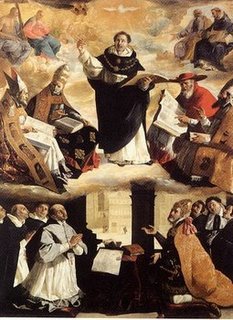Sunday Angelus on Aquinas
 Dear brothers and sisters:
Dear brothers and sisters:Today, the liturgical calendar remembers St. Thomas Aquinas, great doctor of the Church. With his charism as philosopher and theologian, he offers a valid model of harmony between reason and faith, dimensions of the human spirit that are fully realized in their reciprocal encounter and dialog.
According to St. Thomas, human reason 'breathes', so to speak - meaning, it moves through a horizon that is wide and open, in which it can express itself best. But when instead, man is reduced to thinking only of material and experimentable objects but closes himself off to the great questions about life, himself and God, he is impoverished.
The relationship between faith and reason constitutes a great challenge for the dominant culture in the Western world today, and precisely because of this, the beloved John Paul II dedicated an enyclical to it entitled, precisely, Fides et Ratio, faith and reason. I picked up the same theme recently in my discourse at the University of Regensburg.
In fact, modern advances in science have brought innumerable positive effects which will always be acknowledged as such. At the same time, it must be admitted that the tendency to consider true only that which is experimentable constitutes a limitation to human reason and produces a terrible schizophrenia between rationalism and amterialism, hypertechonology and unbridled instinct.
Therefore it is urgent to rediscover in a new way human rationality that is open to the light of the divine Logos (reason) and its perfect revelation in Jesus Christ, Son of God made man.
When it is authentic, Crhistian faith does not subdue freedom and human reason, so why should faith and reason fear each other if, in encounter and dialog, they can both be better expressed?
Faith presupposes reason and perfects it; and reason, illuminated by faith, finds the power to elevate itself to an awareness of God and of spiritual realities. Human reason loses nothing in opening itself to the contents of faith; rather the latter demands the free and conscious application of rwason.
With farsighted wisdom, St. Thomas Aquinas succeeded to establish a fruitful confrontation with the Arab and Jewish thinking in his time, and we consider him even today a master, always valid, of dialog with other cultures and religions.
He knew how to present that wonderful Christian synthesis of reason and faith that is a precious patrimony of Western civilization, which even today we can draw from in order to dialog effectively with the great cultural and religious traditions of the East and of the South.
Let us pray that Christians, especially those who work in the academic and cultural fields, will know how to express the reasonableness of their faith and testify to it in a dialog inspired by love. Let us ask this gift of our Lord through the intercession of St. Thomas Aquinas and above all, of Mary, Seat of Wisdom.
From Papa Ratzinger Forum






